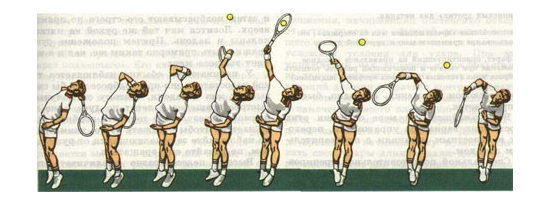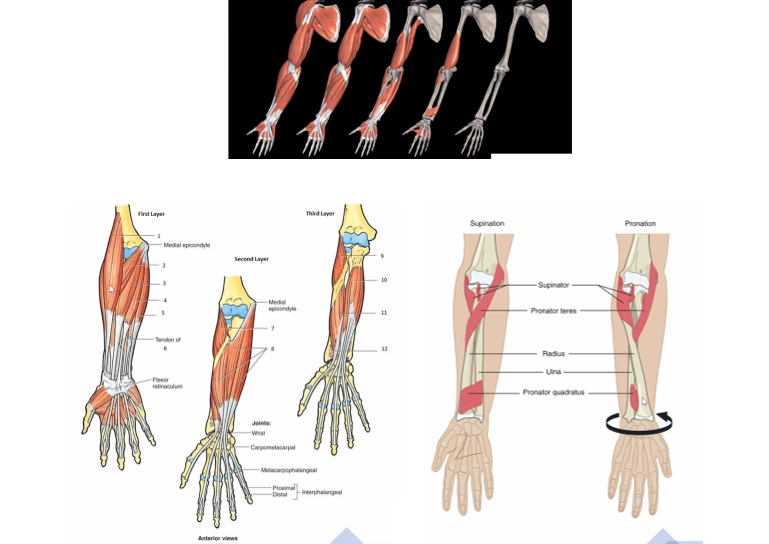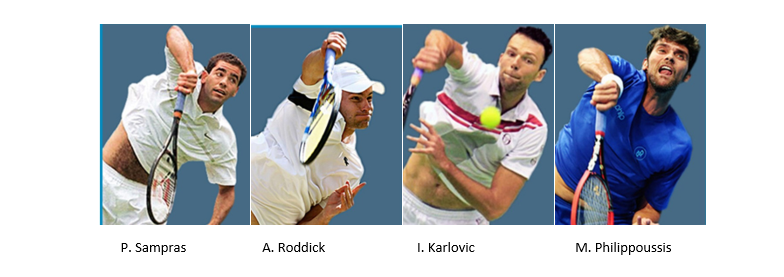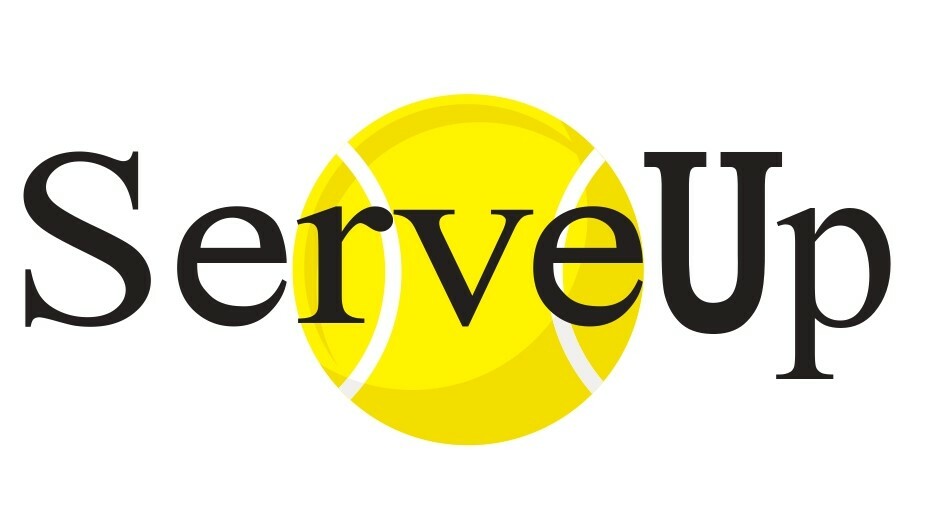The anatomy and physiology of a serve
The serve in tennis is a chain of complex consistent and coordinated biomechanical processes governed by the laws of physics and physiology.
As defined by Newton's second law of motion (F=ma)
In our case
F is the impact force on a ball,
m is ball mass (58.5 g),
a is ball acceleration.
Accordingly, (а=F:m).
(a) - ball speed depends on the impact force on a ball (F) divided by the ball mass (m).
Since the mass of the ball is constant (const), the ball can only be accelerated by increasing the force (F) applied to hit the ball.
The mass of a racket is relatively constant (the standard weight is 300-330 g) and it is selected depending on the age. Therefore, the impact force on a ball (F) can only be increased by increasing the racket speed.
The racket speed depends on initial acceleration (explosive momentum) and terminal speed when the racket makes contact with the ball.
The higher the acceleration, the higher the speed; the higher the speed, the more powerful the shot; the more powerful the shot, the higher the speed of the ball.
By hitting the ball sharply with a heavier racket on ServeUp, you improve the explosive force of your shoulder, arm and hand. The goal is to increase the terminal speed of the racket when in contact with the ball.
Training with a heavier racket and then a lighter racket reduces muscular load and increases the rate of muscle contraction. Such daily trainings give you the chance to get more power on your shots and be more successful in the serve
To understand what exercises you should do to improve your tennis serve, you need to know a few important fundamentals of the physiology of muscle contraction and human anatomy.
In the body, there are three types of muscle tissue: skeletal, smooth, and cardiac (myocardium). As we are talking about serving in tennis, we will address skeletal muscles only.
Skeletal muscles, as their name suggests, are attached to the skeleton bones. Due to their contraction, the muscles maintain the position of the skeleton in space and cause its movement.
Muscle contraction occurs when nerve impulses are transmitted, which causes muscles to shorten. This contraction is called isotonic contraction (IC). The IC speed and strength of muscles involved in serving determine the speed of the racket when it makes contact with the ball, and stroke power. Therefore, you should train your serve to increase such speed and strength of the isotonic contraction of muscles involved in the serve.
Which muscles are involved, and how to achieve this?
In order to gain an insight into how the skeleton and muscles work during a serve, please refer to Figure 1, which provides a schematic representation of a tennis serve.
As defined by Newton's second law of motion (F=ma)
In our case
F is the impact force on a ball,
m is ball mass (58.5 g),
a is ball acceleration.
Accordingly, (а=F:m).
(a) - ball speed depends on the impact force on a ball (F) divided by the ball mass (m).
Since the mass of the ball is constant (const), the ball can only be accelerated by increasing the force (F) applied to hit the ball.
The mass of a racket is relatively constant (the standard weight is 300-330 g) and it is selected depending on the age. Therefore, the impact force on a ball (F) can only be increased by increasing the racket speed.
The racket speed depends on initial acceleration (explosive momentum) and terminal speed when the racket makes contact with the ball.
The higher the acceleration, the higher the speed; the higher the speed, the more powerful the shot; the more powerful the shot, the higher the speed of the ball.
By hitting the ball sharply with a heavier racket on ServeUp, you improve the explosive force of your shoulder, arm and hand. The goal is to increase the terminal speed of the racket when in contact with the ball.
Training with a heavier racket and then a lighter racket reduces muscular load and increases the rate of muscle contraction. Such daily trainings give you the chance to get more power on your shots and be more successful in the serve
To understand what exercises you should do to improve your tennis serve, you need to know a few important fundamentals of the physiology of muscle contraction and human anatomy.
In the body, there are three types of muscle tissue: skeletal, smooth, and cardiac (myocardium). As we are talking about serving in tennis, we will address skeletal muscles only.
Skeletal muscles, as their name suggests, are attached to the skeleton bones. Due to their contraction, the muscles maintain the position of the skeleton in space and cause its movement.
Muscle contraction occurs when nerve impulses are transmitted, which causes muscles to shorten. This contraction is called isotonic contraction (IC). The IC speed and strength of muscles involved in serving determine the speed of the racket when it makes contact with the ball, and stroke power. Therefore, you should train your serve to increase such speed and strength of the isotonic contraction of muscles involved in the serve.
Which muscles are involved, and how to achieve this?
In order to gain an insight into how the skeleton and muscles work during a serve, please refer to Figure 1, which provides a schematic representation of a tennis serve.

Fig 1. Schematic representation of a tennis serve
To understand the anatomical and physiological processes that happen during a serve, let us look into the anatomy of the arm (Figure 2).

Skeletal muscles, as their name suggests, are attached to the skeleton bones. The skeleton of the arm is made up of several groups of bones connected together. Thus, the human arm is three mobile levers connected with ligaments (nunchucku). The levers are set in motion with a large number of muscles. There are many of them, so let us simplify our task and use names of muscle groups instead of names of muscles. They are conventionally divided into "flexors" and "extensors", "pronators" and "supinators". The following movements of the hand are produced by contractions of these muscle groups. (Figure 3)

Flexion, extension, inward rotation (pronation) and outward rotation (supination). All these movements are a vital part of the service motion in tennis. Each muscle group performs a certain function to move the levers.
Now, the most important thing about this is that, the manner, force and speed the muscles contract, joints mobility and amplitude of bones (levers) movement as well as the speed the levers move relative to the axis determine the power of the serve and ball speed.
Now, the most important thing about this is that, the manner, force and speed the muscles contract, joints mobility and amplitude of bones (levers) movement as well as the speed the levers move relative to the axis determine the power of the serve and ball speed.


Here are some important physiological laws to understand the physiological processes involved in serving the ball.
I. The speed of contraction of a muscle fibre decreases as the load increases. The maximum speed is achieved under zero load. Consequently, the racket weight is very important for serving. The heavier the racket, the lower the speed of contraction of a muscle fibre and vice versa. On the other hand, the heavier the racket, the more powerful the shot. An optimal balance is necessary! By gradually increasing the racket weight when training on ServeUp, you will adapt the contraction speed of muscle fibre to the racket weight. Long training with a heavier racket builds stable muscle memory of the racket weight, but once the weight is reduced, the speed of muscle fibre contraction will increase. This, ultimately, helps you achieve the desired result - increase the speed of the racket when striking the ball.
II. There are three fibre types identified in skeletal muscles based on the maximum rate of shortening and predominant mode of ATP (adenosine triphosphate is a universal source of energy for all biochemical processes) formation: slow oxidative, fast oxidative and fast glycolytic. Fast glycolytic fibres are larger in diameter than oxidative fibres and therefore produce higher tension, but fatigue more easily. At the beginning of contraction, slow oxidative motor units are recruited first, then fast oxidative units, and eventually with a very strong contraction, fast glycolytic units are engaged. The involvement of all motor units in contraction increases the speed at which the muscle moves the load. Therefore, in order to achieve maximum speed and power of muscle contraction, you need to do exercises so that to get all the groups of muscle fibres contracted, especially fast glycolytic fibres! ServeUp helps you train all these three muscle fibre groups of the hitting arm.
III. The muscular strength and fatigue can vary throughout the training process
Long low-intensity exercises increase the ability of muscle fibres to generate ATP (universal source of energy for muscle work) using oxidative (aerobic) metabolism. This happens by increasing the number of mitochondria and blood vessels in the muscle. The result is improved muscle endurance. ServeUp allows you to train for better muscular endurance of the hitting arm. And short-term high-intensity exercises increase a fibre diameter due to the actin and myosin synthesis. The result is a higher muscular strength. This is especially important for the muscle groups that perform a very specific function and are rarely used in normal life. These are the pronators and flexors of the wrist (Figure 4). These muscles are crucially important for a strong serve and a targeted methodical training of them with ServeUp is one of the keys to a strong serve.
The relationship between the load and speed of shortening. The speed of muscle fibre shortening declines with increasing load and is determined by repetition of each working cross-bridge cycle and resulting rate of ATP molecule cleavage, as one ATP molecule is cleaved in each cross-bridge cycle. Consequently, with ServeUp you can train exactly the groups of muscle fibres that are used to increase the racket speed to hit the ball.
Muscle length-tension. Muscle stretching not only leads to passive tension of the muscle fibre, but also to a change in its active tension during contraction. Therefore, the force generated by contraction depends on the initial length of the muscle fibre (the more the muscle is stretched before contraction, the greater the contraction force).
Conclusion. Here are few rules to follow for a strong and effective serve in tennis:
1. Adhere fully to the rule of levers. The more levers you use (body, shoulder, forearm, hand and racket) the higher the racket acceleration rate.
2. Improve the endurance and speed of muscle fibre contraction by gradually increasing the weight of the racket during your training and by improving your muscle memory.
3. Adhere fully to the rule of sequential and coordinated biomechanical processes: racket acceleration - long lever; division of the long lever into 3-4 short ones creates an inertial loop to increase the racket acceleration; long lever at the moment the racket makes contact with the ball to increase a stroke power; hand rotation (pronators) to improve a stroke power.
ServeUp design meets all the above challenges.
I. The speed of contraction of a muscle fibre decreases as the load increases. The maximum speed is achieved under zero load. Consequently, the racket weight is very important for serving. The heavier the racket, the lower the speed of contraction of a muscle fibre and vice versa. On the other hand, the heavier the racket, the more powerful the shot. An optimal balance is necessary! By gradually increasing the racket weight when training on ServeUp, you will adapt the contraction speed of muscle fibre to the racket weight. Long training with a heavier racket builds stable muscle memory of the racket weight, but once the weight is reduced, the speed of muscle fibre contraction will increase. This, ultimately, helps you achieve the desired result - increase the speed of the racket when striking the ball.
II. There are three fibre types identified in skeletal muscles based on the maximum rate of shortening and predominant mode of ATP (adenosine triphosphate is a universal source of energy for all biochemical processes) formation: slow oxidative, fast oxidative and fast glycolytic. Fast glycolytic fibres are larger in diameter than oxidative fibres and therefore produce higher tension, but fatigue more easily. At the beginning of contraction, slow oxidative motor units are recruited first, then fast oxidative units, and eventually with a very strong contraction, fast glycolytic units are engaged. The involvement of all motor units in contraction increases the speed at which the muscle moves the load. Therefore, in order to achieve maximum speed and power of muscle contraction, you need to do exercises so that to get all the groups of muscle fibres contracted, especially fast glycolytic fibres! ServeUp helps you train all these three muscle fibre groups of the hitting arm.
III. The muscular strength and fatigue can vary throughout the training process
Long low-intensity exercises increase the ability of muscle fibres to generate ATP (universal source of energy for muscle work) using oxidative (aerobic) metabolism. This happens by increasing the number of mitochondria and blood vessels in the muscle. The result is improved muscle endurance. ServeUp allows you to train for better muscular endurance of the hitting arm. And short-term high-intensity exercises increase a fibre diameter due to the actin and myosin synthesis. The result is a higher muscular strength. This is especially important for the muscle groups that perform a very specific function and are rarely used in normal life. These are the pronators and flexors of the wrist (Figure 4). These muscles are crucially important for a strong serve and a targeted methodical training of them with ServeUp is one of the keys to a strong serve.
The relationship between the load and speed of shortening. The speed of muscle fibre shortening declines with increasing load and is determined by repetition of each working cross-bridge cycle and resulting rate of ATP molecule cleavage, as one ATP molecule is cleaved in each cross-bridge cycle. Consequently, with ServeUp you can train exactly the groups of muscle fibres that are used to increase the racket speed to hit the ball.
Muscle length-tension. Muscle stretching not only leads to passive tension of the muscle fibre, but also to a change in its active tension during contraction. Therefore, the force generated by contraction depends on the initial length of the muscle fibre (the more the muscle is stretched before contraction, the greater the contraction force).
Conclusion. Here are few rules to follow for a strong and effective serve in tennis:
1. Adhere fully to the rule of levers. The more levers you use (body, shoulder, forearm, hand and racket) the higher the racket acceleration rate.
2. Improve the endurance and speed of muscle fibre contraction by gradually increasing the weight of the racket during your training and by improving your muscle memory.
3. Adhere fully to the rule of sequential and coordinated biomechanical processes: racket acceleration - long lever; division of the long lever into 3-4 short ones creates an inertial loop to increase the racket acceleration; long lever at the moment the racket makes contact with the ball to increase a stroke power; hand rotation (pronators) to improve a stroke power.
ServeUp design meets all the above challenges.







